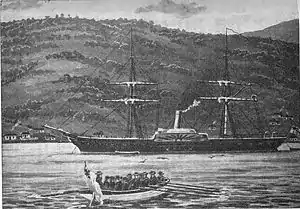 HMS Driver | |
| Class overview | |
|---|---|
| Name | Driver-class paddle sloop |
| Operators | |
| Preceded by | Alecto class |
| Succeeded by | Bulldog class |
| Cost | Driver: £39,707[Note 1] |
| Built | 1840-1846 |
| In commission | 1841–1870s |
| Completed | 10 |
| Retired | 12 |
| General characteristics [1] | |
| Type | Wooden paddle sloop |
| Displacement | 1,590 tons |
| Tons burthen | 1,055+62⁄94 bm |
| Length | 180 ft (54.9 m) (gundeck) |
| Beam | 36 ft (11.0 m) |
| Depth of hold | 21 ft (6.4 m) |
| Installed power | 280–300 nhp (except Devastation and Sphinx) |
| Propulsion |
|
| Sail plan | Brig-rigged |
| Complement | 149 (later 160) |
| Armament |
|
The Driver class were a class of paddlewheel steam sloops of the British Royal Navy. Six Driver-class ships were ordered in 1840 and a further ten in March 1841, although only six were built. Five were ordered in 1847, but all were either built as paddle frigates or cancelled. Two wrecked in service, while the rest served until being retired and were either broken up or sold.
Design
The ships were designed by Sir William Symonds. They were built of wood, displaced 1,590 tons and had a length on the gundeck of 180 feet (54.9 m).[1]
Propulsion
Power was provided by a two-cylinder direct-acting steam engine driving paddle wheels. Spiteful had a side-lever steam engine, Devastation had a 4-cylinder 'Siamese' steam engine and Sphinx had a 2-cylinder oscillating steam engine. The engines developed between 280 and 300 nominal horsepower, apart from Devastation (400 nhp) and Sphinx (500 nhp). All the ships were capable of about 9 knots (17 km/h) under steam, with the more powerful Devastation and Sphinx making 10 or 12 knots.[1] A brig rig was fitted for operating under sail.
Armament
All three ships were armed with two 10 in (250 mm) (84 cwt) guns on pivot mounts, two 68-pounder (64 cwt) guns and two 42-pounder (22 cwt) carronades.[Note 2][1] In 1856 the armament was changed to a single 10-inch pivot gun, a 68-pounder (95 cwt) gun and four 32-pounder (42 cwt) guns. Later, the 68-pounder was replaced by a 110 pdr Armstrong gun breech-loading gun.[1]
Crew
They had a complement of approximately 149 men, increasing later to 160.[1]
Construction
Six Driver-class ships were ordered in 1840[2] and a further ten in March 1841, although only six were built. Five were ordered in 1847, but all were either built as paddle frigates or cancelled.[1]
Ships
| Name | Ship builder[1] | Laid down[1] | Launched[1] | Commissioned[1] | Fate[1] |
|---|---|---|---|---|---|
| Driver | Portsmouth Dockyard | June 1840 | 24 December 1840 | 5 November 1841 | Wrecked on Mayaguana Island in the Bahamas on 3 August 1861 |
| Styx | Sheerness Dockyard | 22 June 1840 | 26 January 1841 | 4 October 1841 | Broken up 1866 |
| Vixen | Pembroke Dockyard | June 1840 | 4 February 1841 | 28 December 1841 | Broken up 12 November 1862 |
| Devastation | Woolwich Dockyard | 27 July 1840 | 3 July 1841 | 30 November 1841 | Broken up September 1866 |
| Geyser | Pembroke Dockyard | August 1840 | 6 April 1841 | 8 March 1842 | Broken up 1866 |
| Growler | Chatham Dockyard | January 1841 | 20 July 1841 | 9 March 1842 | Broken up at Portsmouth by January 1854 |
| Thunderbolt | Portsmouth Dockyard | April 1841 | 13 January 1842 | 8 February 1843 | Wrecked on Cape Recife, Algoa Bay, South Africa 3 February 1847 |
| Cormorant | Sheerness Dockyard | 17 May 1841 | 29 March 1842 | 28 June 1843 | Broken up at Deptford by August 1853 |
| Spiteful | Pembroke Dockyard | August 1841 | 24 March 1842 | 24 March 1843 | Sold September 1883 |
| Eclair | Woolwich Dockyard | August 1841 | 31 May 1843 | 9 September 1844 | Originally Infernal (renamed 26 August 1844 before commissioning. Renamed Rosamund 14 October 1846. Floating factory 1863. Broken up 1865 |
| Virago | Chatham Dockyard | 15 November 1841 | 25 July 1842 | 29 July 1843 | Broken up at Chatham November 1876 |
| Sphinx | Woolwich Dockyard | May 1844 | 17 February 1845 | 3 November 1846 | Broken up at Devonport September 1881 |
| Rattler | - | - | - | - | Ordered 1841, but changed to Alecto-class sloop, then re-ordered as the screw sloop Rattler |
| Bulldog | - | - | - | - | Design lengthened, becoming the first ship of the Bulldog class |
| Inflexible | - | - | - | - | Built as Bulldog class |
| Scourge | - | - | - | - | Built as Bulldog class |
| Furious | - | - | - | - | Ordered in 1847 but then re-ordered as a paddle frigate |
| Magicienne | - | - | - | - | Ordered in 1847 but then re-ordered as a paddle frigate |
| Resolute | - | - | - | - | Ordered in 1847 but then re-ordered as a paddle frigate and finally cancelled in 1850 |
| Tiger | - | - | - | - | Ordered in 1847 but then re-ordered as a paddle frigate |
| Valorous | - | - | - | - | Ordered in 1847 but then re-ordered as a paddle frigate |
Notes
- ↑ A total cost accounting for inflation of approximately £3,803,500 in today's money.
- ↑ "cwt", or "hundredweight" refers to the weight of the gun itself. "42-pounder" refers to the weight of the ball fired.